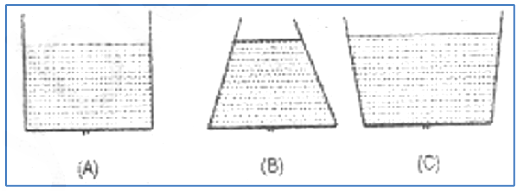 Multiple Choice Questions
Multiple Choice QuestionsA physiological disorder X always leads to the disorder Y. However, disorder Y may occur by itself. A population shows 4% incidence of disorder Y. Which of the following inferences is valid?
4% of the population suffers from both X and Y
Less than 4% of the population suffers from X
At least 4% of the population suffers from X
There is no incidence of X in the given population
Water is dripping out of a tiny hole at the bottom of three flasks whose base diameter is the same, and are initially filled to the same height, as shown

which is the correct comparison of the rate of fall of the volume of the water in the three flasks?
A faster, B slowest
B faster, slowest
B faster, C slowest
C faster, B slowest
C.
B faster, C slowest
Correct option is (c)
Rate of flow is calculated by: V =
Q is flow rate
A= area of the flasks = Πr2
V= volume
The graph represents the depth profile of temperature in the open ocean; in which region this is likely to be prevalent?

Topical region
Equatorial region
Polar region
Sub-tropical region
The area of allowed region in the Ramchandran map will be least for
Gly
L-Ala
L-Prol
A-methyl L- valine
Small RNAs with internally complementary sequences that form hairpin‐like structures, synthesized as precursor RNAs and cleaved by endonucleases to form short duplexes are called:
snRNA
mRNA
tRNA
miRNA
A much greater proportion of energy fixed by autotrophs is transferred to the herbivore level in the open ocean ecosystem than in forest ecosystem because
Aquatic autotrophs are small
Aquatic herbivores are more efficient feeders
Terrestrial autotrophs are less efficient feeders
Terrestrial autotrophs have more indigestible tissues
Polar bears maintain their body temperature because they have more of
Transducin protein
Uncoupling protein
Myoglobin protein
F0F1 ATPase
Transport of water across aquaporins is regulated by the presence of which of the following sequence of three highly conserved amino acids?
Ala‐Asn‐Pro
Pro‐Asn‐Ala
Asn‐Pro‐Ala
Pro‐Ala‐Asn
